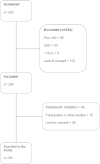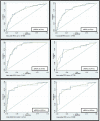Plasma and urine neutrophil gelatinase-associated lipocalin in the diagnosis of new onset acute kidney injury in critically ill patients
- PMID: 24985156
- PMCID: PMC4226989
- DOI: 10.1186/cc13958
Plasma and urine neutrophil gelatinase-associated lipocalin in the diagnosis of new onset acute kidney injury in critically ill patients
Abstract
Introduction: Neutrophil gelatinase-associated lipocalin (NGAL) has been demonstrated to be a useful early diagnostic biomarker of acute kidney injury (AKI) where the timing of the insult is certain. However, NGAL is not well validated in adult critical care practice because of indeterminate timing of injury. Therefore, we sought to establish the predictive ability of both urine and plasma NGAL to detect AKI in ICU patients.
Method: This prospective observational study was performed in a busy large district general hospital mixed surgical-medical ICU in Reading, UK. Consecutive adult admissions to the ICU, with absence of chronic kidney disease, renal transplant or AKI as defined by RIFLE criteria were included. Blood and urine specimens were collected at admission and every 24 hours until 72 hours and tested for NGAL. The purpose of the study was to assess whether urinary NGAL (uNGAL) or plasma NGAL (pNGAL) can predict the occurrence of AKI at an earlier point of time than the conventional markers, that is creatinine and urine output as is used in RIFLE criteria.
Results: Over a 12-month period, 194 patients were enrolled. In total, 59 (30.4%) patients developed AKI. The admission pNGAL and uNGAL were significantly higher in the patients who developed AKI compared to the non-AKI patients (436 ng/mL (240, 797) versus 168 ng/mL (121.3, 274.3) P <0.001 and 342 ng/mL (61.5, 1,280) versus 34.5 ng/mL (11.5, 107.75) P <0.001 respectively). Hospital mortality was higher in the AKI group (17% versus 4%). Plasma NGAL performed fairly on admission (AUROC 0.77) and thereafter performance improved at 24 and 48 hours (AUROC 0.88 and 0.87) following ICU admission. Urine NGAL had a fair predictive value on admission (AUROC 0.79) and at 24 hours (AUROC 0.78) and was good at 48 hours (AUROC 0.82).
Conclusions: In critically ill patients without pre-existing kidney disease, both pNGAL and uNGAL measured at admission can predict AKI (defined by RIFLE criteria) occurrence up to 72 hours post-ICU admission and their performance (AUROC) was fair. The accuracy of NGAL appeared to improve slightly as patients progressed through their ICU stay. Serial measurements of NGAL (both pNGAL and uNGAL) may be of added value in an ICU setting to predict the occurrence of AKI.
Figures





Comment in
-
Biomarkers for acute kidney injury: is NGAL ready for clinical use?Crit Care. 2014 Dec 10;18(6):680. doi: 10.1186/s13054-014-0680-0. Crit Care. 2014. PMID: 25672254 Free PMC article.
References
-
- Devarajan P. Emerging biomarkers of acute kidney injury. Contrib Nephrol. 2007;156:203–212. - PubMed
-
- Devarajan P. The strong silent type: the distal tubule to the rescue. Crit Care Med. 2009;37:2129–2130. - PubMed
-
- Bellomo R, Ronco C, Kellum JA, Mehta RL, Palevsky P. Acute renal failure—definition, outcome measures, animal models, fluid therapy and information technology needs: the Second International Consensus Conference of the Acute Dialysis Quality Initiative (ADQI) Group. Crit Care. 2004;8:R204–R212. - PMC - PubMed
-
- Kellum JA, Hoste EA. Acute kidney injury: epidemiology and assessment. Scand J Clin Lab Invest Suppl. 2008;241:6–11. - PubMed
-
- Ympa YP, Sakr Y, Reinhart K, Vincent JL. Has mortality from acute renal failure decreased? A systematic review of the literature. Am J Med. 2005;118:827–832. - PubMed
Publication types
MeSH terms
Substances
LinkOut - more resources
Full Text Sources
Other Literature Sources
Miscellaneous

